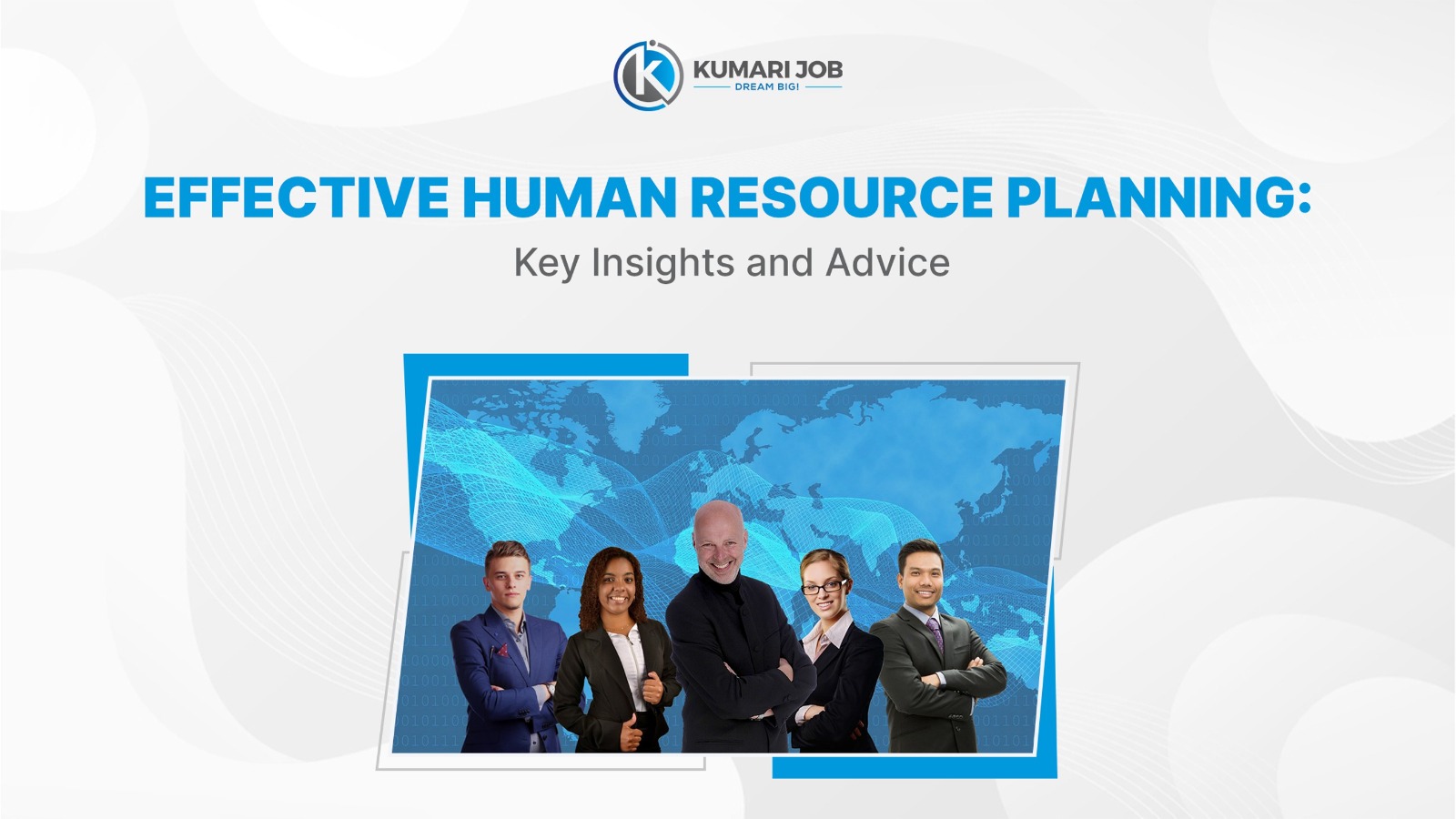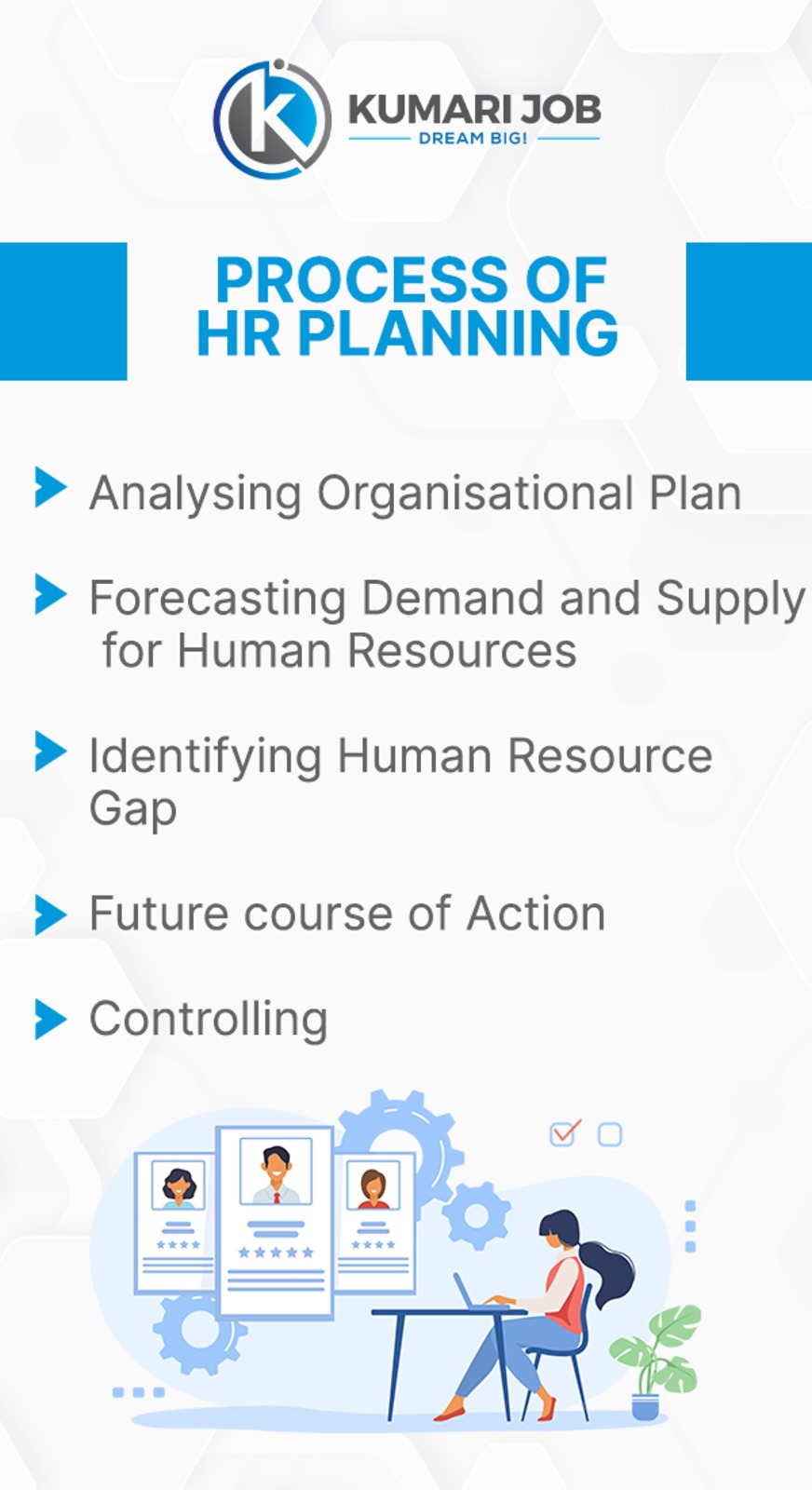
Introduction
Human Resources refers to the individuals who constitute the workforce of an organisation or a country. In a business context, human resources encompass employees at all levels, from entry-level workers to senior executives, contractors, and temporary staff. John R. Commons, an American institutional economist, first coined the term “human resource” in his book “The Distribution of Wealth”, published in 1893. However, it was not until the 20th century that HR departments were formally developed and tasked with addressing misunderstandings between employees and their employers. Human Resource Planning is the continuous process of predicting future workforce needs and developing plans to use employees’ skills and aptitudes optimally.
In other words, Human Resource Planning is the systematic process of forecasting an organisation's future workforce needs and developing strategies and training to meet those needs effectively. It involves analysing the current human resources available within the organisation and external factors such as market trends, technological advancements, and changes in industry regulations.
Human Resource Planning includes determining the necessary training and development programs to enhance the skills and competencies of existing employees to align with future job requirements. Additionally, it involves identifying potential job openings or positions that may arise due to organisational growth, restructuring, or turnover and devising recruitment strategies to fill those roles with qualified candidates. Overall, Human Resource Planning aims to ensure that an organisation has the right people with the right skills and positions at the right time to achieve its objectives efficiently and sustainably.
In this blog
- Introduction
- What is Human Resource Planning? Understanding Human Resource Planning in brief.
- Key Objectives of Human Resource Planning
- Comparison of Short-Term vs. Long-Term Human Resource Planning
- What are the benefits of comprehensive Human Resource Planning?
- Key Components of Human Resource Planning
- Implementing Comprehensive Human Resource Planning
- Challenges and Solutions in Human Resource Planning
- What is human resource training? What is the importance of human resource training?
- Conclusion
- Frequently Asked Questions
What is Human Resource Planning? Understanding Human Resource Planning in brief.
According to Wikipedia, Human Resource Planning is a process that identifies current and future human resource needs for an organisation to achieve its goals. Human Resource Planning should serve as a link between human resource management and the overall strategic plan of an organisation. How? It involves analysing the current workforce, forecasting future staffing needs, and developing strategies to ensure the organisation has the right people with the right skills and positions at the right time.
1. Anticipating Future Needs
By forecasting future workforce requirements, Human Resource Planning enables organisations to address staffing needs and avoid talent shortages or surpluses proactively.
2. Optimising Resource Allocation
Human Resource Planning allows organisations to allocate human resources efficiently, ensuring that resources are utilised effectively to achieve organisational objectives.
3. Enhancing Competitiveness
Strategic workforce planning helps organisations stay ahead of the competition by ensuring they have the talent and skills needed to adapt to changing market conditions and technological advancements.
4. Promoting Agility and Flexibility
Human Resource Planning enables organisations to respond quickly to changes in the business environment, such as shifts in customer demand or regulatory requirements, by aligning their workforce.
5. Fostering Employee Development
By identifying skill gaps and training needs, Human Resource Planning facilitates employee development initiatives, leading to improved job performance, and higher employee satisfaction, and reduced turnover.
Key Objectives of Human Resource Planning
Human resource planning is a strategic process that forecasts future staffing needs, identifies skill and talent gaps, and develops strategies to address them. The key objectives of human resource planning include:
1. Forecasting Future Workforce Needs
Human Resource Planning predicts the organisation's workforce requirements based on business growth, technological advancements, and market trends.
2. Aligning human resource strategies with organisational Goals
Human Resource Planning ensures that human resource strategies and initiatives align closely with the organisation's objectives and goals. This alignment facilitates the achievement of strategic business outcomes.
3. Anticipating Talent Gaps
Human Resource Planning helps identify current and potential talent gaps within the organisation. By anticipating these gaps, human resource professionals can develop strategies to address skill shortages, succession planning needs, and other talent-related challenges.
4. Optimizing Workforce Utilisation
Human Resource Planning aims to optimise the utilisation of the organisation's workforce by ensuring that the right people, with the right skills, are in the right roles at the right time. This involves workforce deployment, talent deployment, and workload balancing.
5. Enhancing Recruitment and Retention
Human Resource Planning focuses on enhancing recruitment and retention efforts by identifying effective sourcing channels, improving candidate selection processes, and implementing strategies to enhance employee engagement and reduce turnover.
Comparison of Short-Term vs. Long-Term Human Resource Planning
Short-Term Human Resource Planning
Short-term Human Resource Planning focuses on immediate staffing needs and resource allocation to meet current operational requirements. It typically involves short-term forecasting, such as staffing levels for the upcoming quarter or year. Short-term Human Resource Planning is more reactive and aims to address the organisation's immediate challenges and opportunities.
Long-Term Human Resource Planning
Long-term Human Resource Planning takes a more strategic approach by considering future workforce needs and planning accordingly. It involves long-term forecasting, often spanning several years, to anticipate changes in the business environment and industry landscape. Longterm Human Resource Planning allows organisations to plan for succession, talent development, and strategic growth initiatives, ensuring sustained success and competitiveness in the long run.
What are the benefits of comprehensive Human Resource Planning?
Human Resource Planning(HRM) is an important area for career development as it focuses on managing the workforce of an organization. Career development in HRM can include various roles such as HR Generalist, Recruiter, Talent Management Specialist, HR Director, etc. Comprehensive human resource planning offers numerous benefits to organisations, including:
1. Alignment with Organizational Goals
It ensures the workforce strategy is closely aligned with its mission, vision, and strategic objectives, enhancing organisational effectiveness and performance.
2. Anticipation of Future Needs
Comprehensive Human Resource Planning allows organisations to anticipate future talent requirements based on business growth projections, industry trends, and changes in the external environment, enabling proactive workforce planning and resource allocation.
3. Optimised Resource Allocation
By accurately forecasting talent needs and identifying skill gaps, HR planning helps optimise resource allocation, ensuring that the right people are in the right roles at the right time and improving productivity and efficiency.
4. Talent Development and Retention
It facilitates talent development initiatives such as training, coaching, and career development programs, fostering employee growth and satisfaction and enhancing retention rates.
5. Succession Planning
Comprehensive HR planning enables organisations to identify and develop future leaders and critical talent, ensuring continuity in key roles and minimising the risk of talent shortages or disruptions.
Key Components of Human Resource Planning
- Workforce Analysis
- Forecasting Demand
- Supply Analysis
- Gap Anaysis
1. Workforce Analysis
This involves evaluating the current composition of the workforce and projecting future staffing needs. It includes assessing factors such as employee skills, experience, and performance to determine the current workforce's adequacy and identify improvement areas.
2. Forecasting Demand
Human Resource Planning requires predicting future workforce requirements based on organisational goals, strategic plans, and external factors such as industry trends, technological advancements, and demographic changes. This involves analysing data and trends to estimate future staffing needs accurately.
3. Supply Analysis
This component evaluates the availability of internal and external talent pools to meet the forecasted demand. It includes assessing factors such as employee turnover rates, internal mobility, recruitment strategies, and the availability of skilled candidates in the external labour market.
4. Gap Analysis
Gap analysis identifies gaps between current capabilities and desired workforce requirements. By comparing the existing workforce's skills, knowledge, and competencies with those needed to achieve organisational objectives. Human Resource professionals can develop strategies to address skill gaps in human resources training, recruitment, or other talent management initiatives.
Implementing Comprehensive Human Resource Planning
1. Steps Involved in Developing and Implementing a Human Resource Planning Strategy
- Assessment: Conduct a thorough assessment of the organisation's current workforce, including skills, competencies, and demographics.
- Forecasting: Predict future workforce needs based on organisational goals, and growth plans and external factors.
- Gap Analysis: Identify gaps between current and future workforce requirements and develop strategies to address them.
- Action Planning: Develop action plans to fill talent gaps in human resources recruitment, training, development, and succession planning.
- Monitoring and Evaluation: Continuously monitor and evaluate the effectiveness of Human Resource Planning strategies and make adjustments as needed.
2. Involvement of Key Stakeholders
- Human Resource Department: Plays a central role in coordinating the Human Resource Planning process, conducting workforce analysis, and developing strategies to address talent gaps.
- Management: Provides input on organisational goals, strategic direction, and resource allocation to support Human Resource Planning initiatives.
- Employees: Engage employees in the Human Resource Planning process by soliciting feedback on skill development needs, career aspirations, and job satisfaction to ensure alignment with organisational goals.
3. Utilising Data Analytics and Technology for Effective Human Resource Planning
- Data Analytics: Utilise data analytics tools to analyse workforce trends, and identify patterns, and make data-driven decisions regarding talent management.
- Technology: Implement Human Resource Planning software and systems to streamline data collection, analysis, and reporting, enabling Human Resource professionals to make informed decisions more efficiently.
- Predictive Modeling: Use predictive modelling techniques to forecast future workforce needs and simulate the impact of different scenarios on talent supply and demand.
Challenges and Solutions in Human Resource Planning
With the growing business environment, many challenges may occur on the path. The challenges in Human Resource Planning are given below:
1. Human Resources identifying training needs
Human Resources determining the specific skills and competencies employees require can be challenging, especially in rapidly evolving industries where new technologies and methodologies emerge frequently.
2. Human Resource aligning training with organisational goals
Ensuring that training initiatives align with the organisation's strategic objectives is crucial but can be difficult when goals are unclear or subject to change.
3. Human Resource budget constraints
Human Resource Limited financial resources may restrict the organisation's ability to invest adequately in training programs, leading to suboptimal skill development and employee dissatisfaction.
4. Human Resource time constraints
Human Resource Balancing the need for training with employees' daily responsibilities can be challenging, particularly in busy work environments where finding time for training sessions is difficult.
5. Human Resource Resistance to training
Some human resources (employees) may resist training initiatives due to various factors, including fear of change, perceived irrelevance of the training, or lack of motivation.
Strategies for Overcoming Human Resource Planning Challenges
Human Resource Planning is crucial for organisations to ensure they have the right talent to achieve their goals. However, it comes with its fair share of challenges. Here are some strategies for overcoming these challenges:
1. Regular and updating
Continuously review and update human resource plans to align with changing business needs, market dynamics, and regulatory requirements. This ensures that the organisation remains agile and responsive to evolving circumstances.
2. Integrated approach
Integrate Human Resource Planning with strategic business planning to ensure alignment with organisational goals and objectives. This facilitates better resource allocation and decision-making.
3. Data-driven decision-making
Utilise data analytics and forecasting techniques to identify trends, anticipate future workforce needs, and make informed decisions. Leveraging technology and data analytics tools can enhance the accuracy and effectiveness of Human Resource Planning efforts.
4. Stakeholder collaboration
Foster collaboration and communication among stakeholders, including senior management, department heads, and employees, to gather input, gain buy-in, and ensure that human resource plans reflect diverse perspectives and needs.
5. Talent development and retention
Invest in talent development initiatives, such as training and development programs, mentoring, and career pathways, to enhance employee skills, engagement, and retention. Creating a supportive work environment that values employee growth and development can help attract and retain top talent.
What is human resource training? What is the importance of human resource training?
Human resource training refers to the process of providing employees with the knowledge, skills, and abilities required to perform their jobs effectively. It encompasses various types of learning activities, including workshops, seminars, on-the-job training, online courses, and formal education programs. The goal of human resource training is to enhance individual and organizational performance by improving employees' competencies, increasing their job satisfaction, and supporting the achievement of organizational goals.
The importance of human resource training can be understood through several key points:
1. Skill Development: Training helps employees develop new skills and competencies or enhance existing ones, enabling them to perform their jobs more effectively and efficiently.
2. Increased Productivity: Well-trained employees are typically more productive, as they are better equipped to handle their tasks and responsibilities, leading to improved work output and performance.
3. Adaptation to Change: In today's fast-paced and dynamic business environment, organizations often undergo changes in technology, processes, or market conditions. Training helps employees adapt to these changes by providing them with the necessary knowledge and skills to navigate new challenges and opportunities.
4. Employee Engagement and Retention: Offering training opportunities demonstrates a commitment to employee development, which can enhance job satisfaction, engagement, and loyalty. Employees are more likely to stay with an organization that invests in their growth and development.
5. Improved Quality of Work: Proper training can lead to a higher quality of work output, as employees are better equipped to understand and adhere to best practices, quality standards, and organizational policies and procedures.
6. Enhanced Innovation and Creativity: Training programs can stimulate innovation and creativity by exposing employees to new ideas, perspectives, and ways of thinking. This can lead to the generation of innovative solutions to business challenges and opportunities.
7. Succession Planning: Training plays a crucial role in succession planning by preparing employees to take on new roles and responsibilities as they advance within the organization. It helps build a pipeline of talent for future leadership positions.
8. Compliance and Risk Management: Certain training programs, such as those focused on workplace safety, ethics, and regulatory requirements, are essential for ensuring legal compliance and mitigating risks associated with non-compliance.
Overall, human resource training is essential for fostering a skilled, engaged, and adaptable workforce that can drive organizational success and competitiveness in today's ever-evolving business landscape.
Conclusion
In conclusion, Human Resource Planning is essential for building agile, high-performing teams aligned with business goals. It supports talent development, compliance, and innovation while preparing organizations for future challenges. For those looking to strengthen these skills, HR training in Nepal like the programs offered by Kumari Job—can be a valuable step toward strategic workforce management.
Frequently Asked Questions
Human Resource Planning helps create an organisational climate for competence, committment and performance and prevent the need for suddenly dismissing employees, which is not easy.
Limited HR expertise: Many organizations in Nepal lack HR professionals with comprehensive knowledge and expertise in managing human resources. This leads to inefficient recruitment and selection processes, inadequate performance management, and insufficient employee development initiatives.
5 steps for strategic human resource planning
- Step 1: Assess your organisational goals and plans
- Step 2: Evaluate employee skillsets
- Step 3: Forecast your future HR needs
- Step 4: Hone your talent development strategies
- Step 5: Review and evaluate your action plan
The factors which affect HR Planning are the type and strategy of the organisation, organisation growth cycles and planning, environmental uncertainties, time horizons, type and quality of information, nature of jobs being filled and outsourcing.
The three key elements of the HR planning process are forecasting labour demand, analysing present labour supply, and balancing projected labour demand and supply.









Loading Comments...